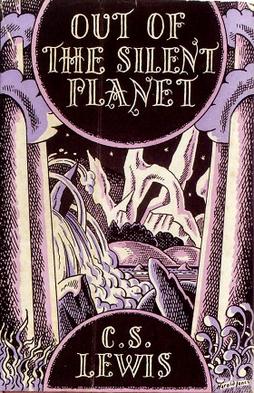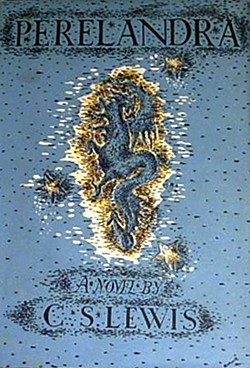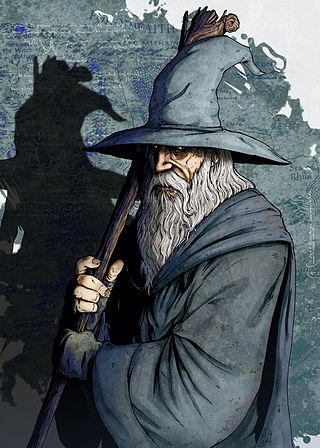
Clive Staples Lewis was a British writer, literary scholar, and Anglican lay theologian. He held academic positions in English literature at both Magdalen College, Oxford (1925–1954), and Magdalene College, Cambridge (1954–1963). He is best known as the author of The Chronicles of Narnia, but he is also noted for his other works of fiction, such as The Screwtape Letters and The Space Trilogy, and for his non-fiction Christian apologetics, including Mere Christianity, Miracles, and The Problem of Pain.

The Lord of the Rings is an epic high fantasy novel by the English author and scholar J. R. R. Tolkien. Set in Middle-earth, the story began as a sequel to Tolkien's 1937 children's book The Hobbit, but eventually developed into a much larger work. Written in stages between 1937 and 1949, The Lord of the Rings is one of the best-selling books ever written, with over 150 million copies sold.

Gandalf is a protagonist in J. R. R. Tolkien's novels The Hobbit and The Lord of the Rings. He is a wizard, one of the Istari order, and the leader of the Fellowship of the Ring. Tolkien took the name "Gandalf" from the Old Norse "Catalogue of Dwarves" (Dvergatal) in the Völuspá.

That Hideous Strength: A Modern Fairy-Tale for Grown-Ups is a 1945 novel by C. S. Lewis, the final book in Lewis's theological science fiction Space Trilogy. The events of this novel follow those of Out of the Silent Planet and Perelandra and once again feature the philologist Elwin Ransom. Yet unlike the principal events of those two novels, the story takes place on Earth rather than elsewhere in the Solar System. The story involves an ostensibly scientific institute, the N.I.C.E., which is a front for sinister supernatural forces.
Tuor Eladar and Idril Celebrindal are fictional characters from J. R. R. Tolkien's Middle-earth legendarium. They are the parents of Eärendil the Mariner and grandparents of Elrond Half-elven: through their progeny, they become the ancestors of the Númenóreans and of the King of the Reunited Kingdom Aragorn Elessar. Both characters play a pivotal role in The Fall of Gondolin, one of Tolkien's earliest stories; it formed the basis for a section in his later work, The Silmarillion, and was expanded as a standalone publication in 2018.

Out of the Silent Planet is a science fiction novel by the British author C. S. Lewis, first published in 1938 by John Lane, The Bodley Head. Two sequels were published in 1943 and 1945, completing the Space Trilogy.

Perelandra is the second book in the Space Trilogy of C. S. Lewis, set on the planet of Perelandra, or Venus. It was first published in 1943.
The Notion Club Papers is an abandoned novel by J. R. R. Tolkien, written in 1945 and published posthumously in Sauron Defeated, the 9th volume of The History of Middle-earth. It is a time travel story, written while The Lord of the Rings was being developed. The Notion Club is a fictionalization of Tolkien's own such club, the Inklings. Tolkien's mechanism for the exploration of time is through lucid dreams. These allow club members to experience events as far back as the destruction of the Atlantis-like island of Númenor, as narrated in The Silmarillion.

The Fisher King is a figure in Arthurian legend, the last in a long line of British kings tasked with guarding the Holy Grail. The Fisher King is both the protector and physical embodiment of his lands, but a wound renders him impotent and his kingdom barren. Unable to walk or ride a horse, he is sometimes depicted as spending his time fishing while he awaits a "chosen one" who can heal him. Versions of the story vary widely, but the Fisher King is typically depicted as being wounded in the groin, legs, or thigh. The healing of these wounds always depends upon the completion of a hero-knight's task.

The Dark Tower is an incomplete manuscript written by C. S. Lewis that appears to be an unfinished sequel to the science fiction novel Out of the Silent Planet, though doubts have been raised about its authenticity. Perelandra instead became the second book of Lewis' Space Trilogy, concluded by That Hideous Strength. Walter Hooper, Lewis' literary executor, titled the fragment and published it in the 1977 collection The Dark Tower and Other Stories. The Lewis scholar Kathryn Lindskoog challenged the authenticity of the work.
The Space Trilogy is a series of science fiction novels by C. S. Lewis. The trilogy consists of Out of the Silent Planet (1938), Perelandra (1943), and That Hideous Strength (1945). A philologist named Elwin Ransom is the protagonist of the first two novels and an important character in the third.
Professor Weston is a Satanic character in C. S. Lewis's The Space Trilogy. He is introduced in the trilogy's first book, Out of the Silent Planet (1938), as an eminent physicist who has invented space travel. He is defeated by the novel's protagonist Elwin Ransom on Mars. Weston returns in the second book, in an attempt to wreak havoc on Venus (Perelandra), the "new Eden".

The Princess and the Goblin is a children's fantasy novel by George MacDonald. It was published in 1872 by Strahan & Co., with black-and-white illustrations by Arthur Hughes. Strahan had published the story and illustrations as a serial in the monthly magazine Good Words for the Young, beginning November 1870.
Stories involving the mythical wizard Merlin have been popular since the Renaissance, especially with the renewed interest in the legend of King Arthur in modern times. As noted by Arthurian scholar Alan Lupack, "numerous novels, poems and plays center around Merlin. In American literature and popular culture, Merlin is perhaps the most frequently portrayed Arthurian character."
Frodo Baggins is a fictional character in J. R. R. Tolkien's writings and one of the protagonists in The Lord of the Rings. Frodo is a hobbit of the Shire who inherits the One Ring from his cousin Bilbo Baggins, described familiarly as "uncle", and undertakes the quest to destroy it in the fires of Mount Doom in Mordor. He is mentioned in Tolkien's posthumously published works, The Silmarillion and Unfinished Tales.

The Wizards or Istari in J. R. R. Tolkien's fiction were powerful angelic beings, Maiar, who took the form of Men to intervene in the affairs of Middle-earth in the Third Age, after catastrophically violent direct interventions by the Valar, and indeed by the one god Eru Ilúvatar, in the earlier ages.

The roles of women in The Lord of the Rings have often been assessed as insignificant, or important only in relation to male characters in a story about men for boys. Meanwhile, other commentators have noted the empowerment of the three major women characters, Galadriel, Éowyn, and Arwen, and provided in-depth analysis of their roles within the narrative of The Lord of the Rings.
Commentators have compared Peter Jackson's 2001–2003 The Lord of the Rings film trilogy with the book on which it was based, J. R. R. Tolkien's 1954–1955 The Lord of the Rings, remarking that while both have been extremely successful commercially, the film version does not necessarily capture the intended meaning of the book. They have admired Jackson's ability to film the long and complex work at all; the beauty of the cinematography, sets, and costumes; the quality of the music; and the epic scale of his version of Tolkien's story. They have, however, found the characters and the story greatly weakened by Jackson's emphasis on action and violence at the expense of psychological depth; the loss of Tolkien's emphasis on free will and individual responsibility; the flattening out of Tolkien's balanced treatment of evil to a simple equation of the One Ring with evil; and the replacement of Frodo's inner journey by an American "hero's journey" or monomyth with Aragorn as the hero.
The presence of sexuality in The Lord of the Rings, a bestselling fantasy novel by J. R. R. Tolkien, has been debated, as it is somewhat unobtrusive. However, love and marriage appear in the form of the warm relationship between the hobbits Sam Gamgee and Rosie Cotton; the unreturned feelings of Éowyn for Aragorn, followed by her falling in love with Faramir, and marrying him; and Aragorn's love for Arwen, described in an appendix rather than in the main text, as "The Tale of Aragorn and Arwen". Multiple scholars have noted the symbolism of the monstrous female spider Shelob. Interest has been concentrated, too, on the officer-batman-inspired same-sex relationship of Frodo and his gardener Sam as they travel together on the dangerous quest to destroy the Ring. Scholars and commentators have interpreted the relationship in different ways, from close but not necessarily homosexual to plainly homoerotic, or as an idealised heroic friendship.








